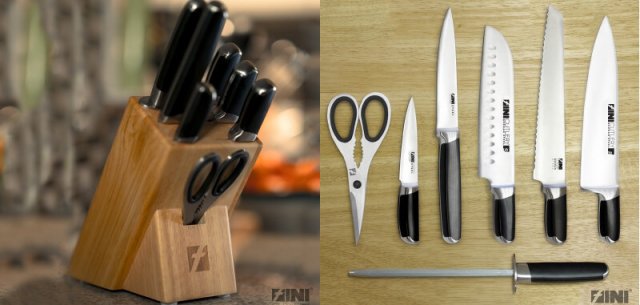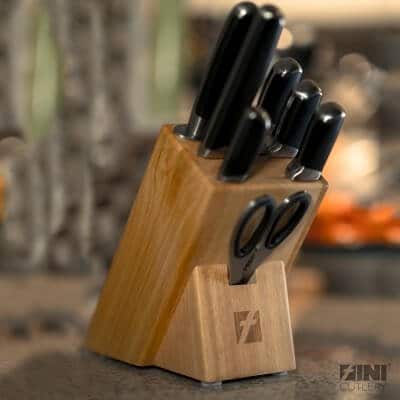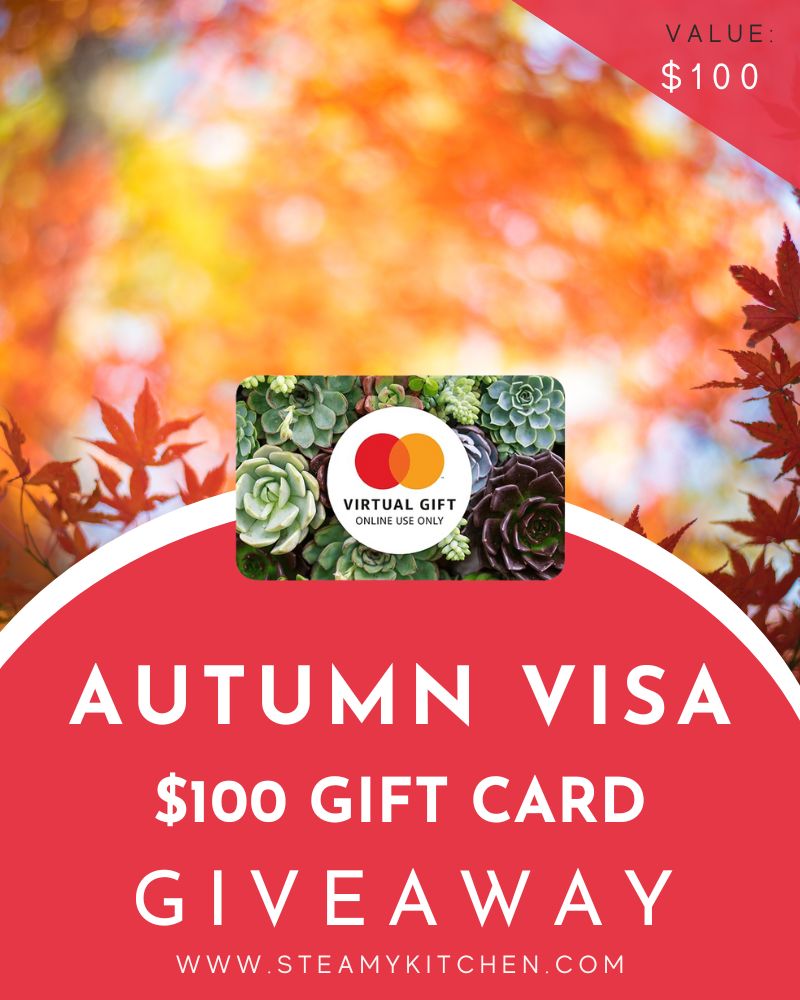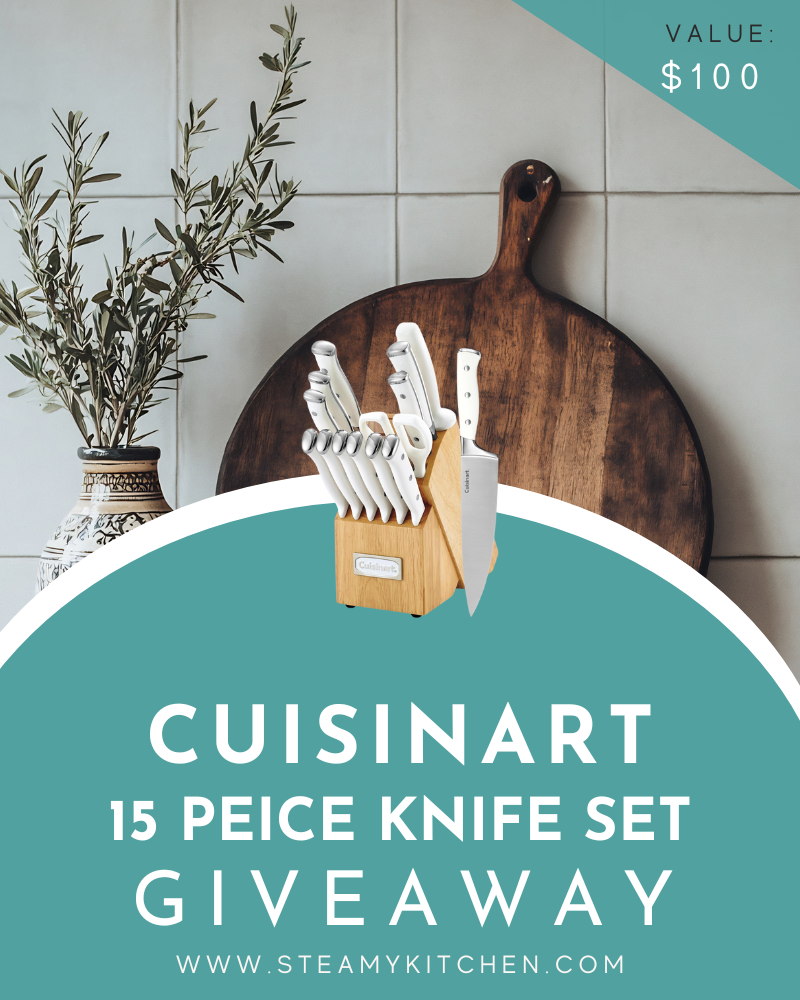
I know, I know. These are the funniest looking knives you’ve ever seen. They are stumpy and are missing half the handle! But don’t underestimate the Fini Cutlery Knives, we’ve been testing this set for over 45 days with daily use. Our Fini Cutlery Knives review includes both PROs and CONs.
Fini Cutlery Knives Review – PROs and CONs
Let’s first start with an overview of these knives. Fini Cutlery began their business on Kickstarter by 20 year restaurant veteran, Peter Rigas, in New York.
Watch this video – it will explain the features of the Fini Knives better than I ever could:
Fini Cutlery Knives Stats
- Rockwell Hardness 58
- German Steel 1.4116
- Made in China
- Double ground edge of 20° angle, the Santoku has a hollow ground edge.
- 30 day warranty

Design forces you to pinch-grip – PRO!
Most high-end kitchen knife manufacturers focus their innovation on the fine balance between hardness of the blade (Rockwell Hardness), angle of the edge (European vs. Asian style) and type of steel (Japanese or German steel). Lower-end knife companies pay attention to how pretty their knives look in your kitchen.
Very few manufacturers actually set out to design the chef’s knife from scratch. If you watched the video above, you’ll see that Fini actually zeroed in on proper knife handling influencing the design.
There’s no way to use the Fini knives without the pinch grip. Your thumb and forefinger actually pinch the blade, while the rest of your fingers and palm wrap securely around the handle. This grip stabilizes the knife, minimizing wobble, and giving you the ultimate control of the knife.

A short, stubby handle allows your last two fingers to close around the butt of the knife. Again, affects stability and control of the knife. Mincing herbs or chopping celery with just 2 fingertips like in the video? Yup, I tried that, astonished that it actually worked.

Fini Cutlery Material – PRO
The steel is German steel 1.4116 – I’m not a metallurgist, and there’s very little information online that I can find out this type of steel. I’ll provide more info when I get it from Fini. From their website, “We selected German Forged 4116 stainless steel with a balance of carbon and chromium for a high degree of corrosion resistance, strength and edge retention.”
Rockwell Hardness of 58 + 20° angle: this is typical of European style knives. From my favorite electric knife sharpening company, Chef’s Choice:
European knives have a 20° angle and softer Rockwell Hardness than Asian knives (15°, and usually 60-61 Rockwell Hardness). Asian blades are thinner, harder, but that means it is more prone to chipping/breaking if dropped. Also, takes longer to hone and sharpen. The thinner, more precise blade makes it easier to thinly slice vegetables, seafood, small pieces of meats for stir fries.
European blades are sturdier, thicker, made for cutting through squash, big meats, potatoes, butchering poultry. They are easier to hone and sharpen.
Which is better? the European style or Asian style? It’s all personal preference and really depends on what type of cutting you do. Please note that the Fini Santoku knife has a hollow ground blade – which allows vegetables to slide off more easily from blade.
Steel from Germany, Made in China
I can’t say whether this is a PRO or CON. I’m made in China (well, actually Hong Kong) so it would be hypocritical to say it’s a CON! 🙂
Those handles again
I can’t stop talking about those handles. According to the founder of Fini, each knife’s handle was designed based on the particular knife’s use. You’ll notice in these photos below that each knife’s handle is just a little different.
My Mom won’t give them back
My Mom just had hand surgery for arthritis. Her biggest worry was not being able to use a knife post surgery. There are only 2 sets of knives that she can use. The first one is the Anolon SureGrip set because of the cushy handles.
Mom came over the day I unboxed the Fini set. We used the knives to cut a few things just to test it out for few minutes before heading out to dinner.
After dinner, Mom snuck the Fini knife set back into conversation — she wanted my knives! She felt ZERO pain using these knives. That’s because instead of using every finger and every part of her palm to hold and stabilize the knife, she was only using 2 fingers on the blade for control and stability. The rest of the handle nestles in her palm with minimal effort.
She won’t give me these knives back. LOL.
Each Fini Knife: PROs and CONs.

PRO: The Chef’s Knife has an 8″ blade, great size and heft for mincing and chopping. Of all the knives in the set, this one is my favorite. It feels good, like an extension of my hand.
CON: To make the knife even MORE comfortable, I wish the bolster was shaped differently (that’s the thick piece between blade and handle). I wish it was curved with gentle slope, like the Misen Knife.

PRO: The Fini Santoku knife is Mom’s go-to knife for vegetables. The dimples on the side of the blade helps the vegetables slide off the blade.
CON: I wish this was a true Japanese style knife with thinner blade, thinner edge. I feel clumsy using this thicker blade Santoku knife for the type of vegetable cutting it’s designed for. Thin match-sticks of carrot, bell pepper, celery, zucchini and cucumber. Paper thin slices of onions and garlic cloves.
 Here’s another thing I don’t like about this particular knife. See this pointy corner?
Here’s another thing I don’t like about this particular knife. See this pointy corner?
It’s super sharp. Both my Mom and I have pricked and cut ourselves with this corner. Because there is a 1/2 bolster on this knife, the blade edge is exposed. Normally, half bolsters are great because that gives me the entire blade to work with and the entire blade to sharpen.
On this knife, the corner is deadly. It’s a simple fix, just take a metal file and rub it a few times to dull that corner.

The Fini Bread Knife is a fine specimen. Love everything about it. For some reason that corner blade edge is a little softer than the Santoku. It could use a tiny bit of filing down, but it’s not bad.

PRO: The Fini Paring Knife is made for doing peeling work – like paring an apple with the paring knife cradled in your palm. Peeling skin off onions or garlic.
CON: Another very sharp corner on the blade. My personal opinion – that shape of the blade is a little funky. That little indentation of the blade right at my forefinger gets in the way. When I hold this knife in my hand, paring an apple, that little corner digs into my finger. Ouch. Again, a simple metal file will help dull that corner.

PRO: This is the utility knife, but it has a normal sized handle. I asked founder, Peter Rigas, why the utility knife didn’t have a stubby end:
“The Utility Knife is used and held in many different ways for various tasks. It is why the industry calls it “Utility”
Sometimes you are low with it, cutting sideways butterflying a chicken breast or a filet (which can be done with our chef’s knife as well)…sometimes you may be holding it high in the palm of your hand pointing down to cut around a ham bone or a roast. (the way Norman Bates held his knife):)If you need a longer handle, its because you need a different blade, a different knife…for a specific task. That is why knife sets come with many knives. Unfortunately few know how to use them so they end up struggling through work, using the one knife in the set that they are comfortable with.
If you look at our paring knife, for example…that handle is also different from the rest of them. It is a pear shaped handle designed to fit comfortably in your hand for any task the knife is used for…paring, deflowering strawberries, small cutting board tasks, etc…That knife alone took hundreds of hours to perfect and is only used on our paring knife.
FINI are the only knives where each handle is specifically designed for the tasks they are built for. Usually knives are designed with one handle design and then ONLY the handle size increases or decreases based on the size of the blade. The shape stays the same. This made no sense to us. It’s the actual shape of the handle that matters. We designed our knives in reverse. We first listed the work each particular knife would need to do and then designed handles around the work list, and lastly fitted them with blades.
However, at first glance, some experienced Chefs thought they would lose the leverage needed for carving a chicken or smashing garlic and other similar tasks using our 8″ Chef’s knife. Honestly, it does appear that way. But after using it, they realize that the handle totally locks into their hand, delivering more power and more control…not less. We even incorporated design features that make it comfortable to hold it upside down to scrape food off the cutting board. Try doing this to see. ” – Chef Peter Rigas, Founder, Fini Cutlery
CON: I wish the utility knife’s blade was just a tiny bit longer and the handle a tiny bit shorter. The blade is just a tad to short for me, personally, as an all-purpose utility knife . The handle feels too big, after using the other knives in the set. It’s just a matter of getting used to which knife does what.

PRO: It’s a great size for small hands
CON: It’s uncomfortable! Fini spent so much time designing the knives, I feel that the shears were neglected. They are thin in the handles and the finger holes are small. Even with my small hands, I have to crowd my fingers into the handles.

Price
You can purchase direct from Fini’s website. I think that’s the only place they sell them. I’m NOT an affiliate partner, nor have I gotten paid for the 12 hours we spend testing, writing, photographing, editing and publishing this post.
The entire set sells for $300 (as of time of publishing, which is 2 days after Thanksgiving 2016). It’s a great price for what you are getting: the design innovation, German steel, every knife you’d ever need and a system that really forces you to hold a knife correctly.
Final Thoughts about Fini Cutlery Knives
My Mom will never give this set back to me. She loves it so much and can prep food, pain free.
The Fini Cutlery Knives are perfect for all cooks of all levels. For beginners, this set will really force the cook to be safer in the kitchen with correct handling. For more experienced cooks who are in the kitchen day in, day out, this set is a welcome relief. Your hands are less tired. Cutting is easier. People with hand, wrist and arm pain, my Mom says to try the knives.
I have tendonitis, carpal tunnel and tennis elbow which results in chronic pain in my arms. I won’t give up tennis (it’s my happy place), I won’t give up typing (eh, our entire family business is based on words on screen!). When my pain flares up, the last three fingers on my hand gets affected the most and I have very poor grip. The Fini knives were perfect – I didn’t have to rely on the strength of my last three fingers to stabilize a long handle of a chef’s knife.
It’s a smart set. I love that the designers started design from scratch — and built the line based on functionality. I love supporting entrepreneurs who take a bold stand and disrupt the industry. Despite the CONs I’ve pointed out, it’s still a set I highly recommend. I think there could be teeny tiny refinements to be made, but I’m being ultra detailed in this review.
If I had to just pick one knife to try, I would get the 8″ Chef’s Knives. Fini features a 30 day guarantee (you just pay for shipping back). Head over to their website and see what some chefs are saying about Fini. (We are NOT affiliate partners, and we do NOT get commission from Fini)
Fini Cutlery Knives Giveaway (8-piece set)




























































0 Comments